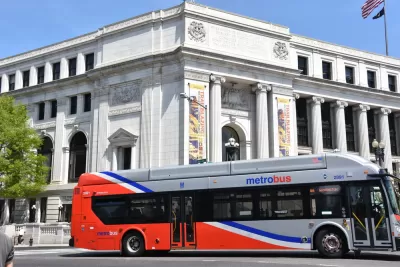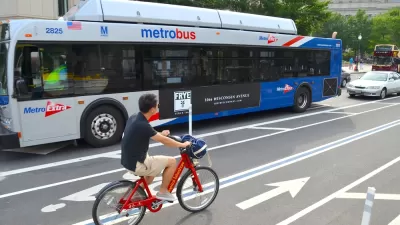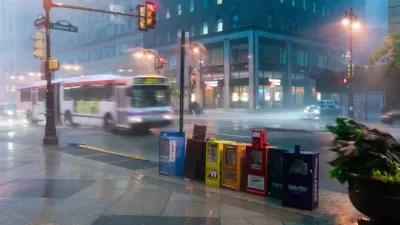A debate about how to more efficiently operate the Washington Metropolitan Area Transit Authority's bus service is underway.

A recent episode of the Kojo Nmamdi Show on WAMU in Washington, D.C. dug into proposed service reductions on the bus routes on the Washington Metropolitan Area Transit Authority (WMATA) system, as included in a fiscal year budget released in February.
Here the show's website explains the context for the show:
Last month, WMATA released their FY2021 budget. The transit authority is proposing consolidating or eliminating bus lines, in an effort to cut expenses. Dozens of bus lines across the region are in jeopardy of being cut or merged due to low ridership. Although these plans are not finalized, riders are protesting the cuts.
Guests on the show include Margaret Barthel, WAMU transportation reporter; Rob Puentes, chair of ENO Transportation and board member of the Bus Transformation Project; and Brian Turmail, chair of Advisory Neighborhood Commission 3B.
As explained in a February 7 article by Barthel, the WMATA is proposing the cuts as a mean to "reduce redundancy, make routes easier to understand and prune lines with low ridership." According to Barthel, "Metro also says the cuts will allow for better weekend service, increased bus frequency on some lines and free transfers between rail and buses. Eighteen lines also could have service expanded under the budget plans."
Barthel's coverage of the propose cut also includes soundbites from bus riders and local officials who oppose the service cuts.
A Planetizen article from May 2019 shares information about the plans by the Bus Transformation Project to improve bus service around the D.C. region. Opponents of the service cuts have claimed the proposed cuts are antithetical to the plan proposed by the Bus Transformation Project.
FULL STORY: WMATA Proposes Cuts to Dozens of Bus Routes. What’s Next?

Trump Administration Could Effectively End Housing Voucher Program
Federal officials are eyeing major cuts to the Section 8 program that helps millions of low-income households pay rent.

Planetizen Federal Action Tracker
A weekly monitor of how Trump’s orders and actions are impacting planners and planning in America.

Ken Jennings Launches Transit Web Series
The Jeopardy champ wants you to ride public transit.

Washington Legislature Passes Rent Increase Cap
A bill that caps rent increases at 7 percent plus inflation is headed to the governor’s desk.

From Planning to Action: How LA County Is Rethinking Climate Resilience
Chief Sustainability Officer Rita Kampalath outlines the County’s shift from planning to implementation in its climate resilience efforts, emphasizing cross-departmental coordination, updated recovery strategies, and the need for flexible funding.

New Mexico Aging Department Commits to Helping Seniors Age ‘In Place’ and ‘Autonomously’ in New Draft Plan
As New Mexico’s population of seniors continues to grow, the state’s aging department is proposing expanded initiatives to help seniors maintain their autonomy while also supporting family caregivers.
Urban Design for Planners 1: Software Tools
This six-course series explores essential urban design concepts using open source software and equips planners with the tools they need to participate fully in the urban design process.
Planning for Universal Design
Learn the tools for implementing Universal Design in planning regulations.
Heyer Gruel & Associates PA
Ada County Highway District
Institute for Housing and Urban Development Studies (IHS)
City of Grandview
Harvard GSD Executive Education
Toledo-Lucas County Plan Commissions
Salt Lake City
NYU Wagner Graduate School of Public Service





























